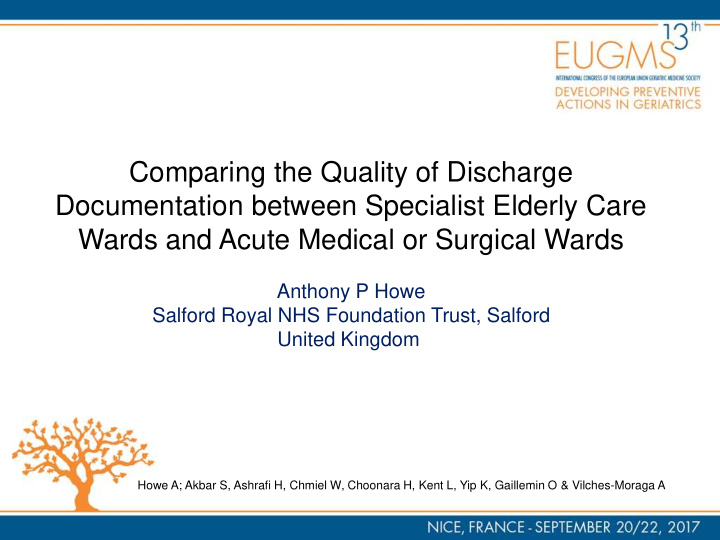



Comparing the Quality of Discharge Documentation between Specialist Elderly Care Wards and Acute Medical or Surgical Wards Anthony P Howe Salford Royal NHS Foundation Trust, Salford United Kingdom Howe A; Akbar S, Ashrafi H, Chmiel W, Choonara H, Kent L, Yip K, Gaillemin O & Vilches-Moraga A
CONFLICT OF INTEREST DISCLOSURE I have no conflicts of interest to declare
Background Forms part of ongoing audit cycle started in July 2016 to assess quality of discharge summaries Broader scope to assess quality of those documents across all directorates; Ageing and Complex Medicine, Ortho-geriatrics, General Surgery and Acute Medicine - Further analysis comparing between these directorates Salford Royal: • 850+ bed teaching hospital in the north west of England, UK • It serves the needs of a local population as well as acting as a tertiary centre for neurosciences, dermatology, renal medicine, general surgery and intestinal failure
Rationale Good quality documentation is essential to the safe transition of care for elderly patients at the point of discharge. High quality discharge documentation is used to: • Safely facilitate transfer of care from hospital to the community • Serve as a record of the events of an admission for health care providers • Communicate with patients, relatives and carers: • This may be single source of information regarding the events of an admission • Some experience lengthy hospital admissions or develop an acute confusional state or have established underlying cognitive impairment. • This may affect the ability to recall events and follow up plans after discharge. • Some have care provided by relatives or health care professionals who may not be fully aware of the events of the admission
Methodology Utilising electronic patient record (EPR) – Sunrise Allscripts Established national (Academy of Medical Royal Colleges 2013) and local (Salford Royal NHS FT) guidance on discharge summaries Inclusion criteria: all patients aged ≥ 74 years Inpatient admission and discharge to community (home or care facility) from Ageing and Complex Medicine (ACM); Orthogeriatric, General Surgical and Acute Medical wards Two cycles of data collection Jan – Feb 2017 and April 2017
Methodology Data Collected: 32 data points including: Basic information: Length of admission, location Demographics: Age and sex Authorship: Role, whether involved, weekday vs. weekend Acute kidney injury: If diagnosed; whether this is recorded, appropriate follow up Clinical information: Past medical history, new diagnoses, summary of admission, relevant investigations/procedures Social/functional: Assessment documented, community care provision Medicines: Whether started, stopped or amended + rationale Communicating care: Follow up details, action for GP Patient information: Summary in lay terms, contact information Dementia/delirium: Diagnoses and interventions recorded Comparisons between ACM and non-ACM wards
Results D e m o g r a p h i c s & a u t h o r s h i p 321 records reviewed Role ACM Average age: 83.2 years Foundation (1 – 2) 37.3% Male 120 Female 201 70.5% Core Trainees (3 – 4) 33.2% Author Role: Specialty Trainees 15.2% (5+) Consultant 7.1% ANP/Pharmacist 3.7% Medical Students 3.4% Authorship: Data ACM Non-ACM Author involved in 95% 84% patient care Weekday 98% 93%
Results C l i n i c a l i n f o r m a t i o n a n d A K I Clinical information: ACM Non-ACM Summary of visit 98% 93% Investigations or 96% 93% procedures Clear list of new diagnoses 69% 57% Updated past medical 65% 38% history Acute kidney injury: Incidence 25.8% 17.4% Documented 93.1% 95.8% Appropriate follow up 73.6% 80.0%
Results S o c i a l a n d f u n c t i o n a l i n f o r m a t i o n Care facility ACM Non-ACM % of patients from care facility 34.1% 16.4% documentation 81.8% 46.7% Functional assessment ACM Non-ACM documentation 25.8% 19.9%
Results M e d i c a t i o n c h a n g e s ACM Non-ACM Medication regime change 79% 84% documented Rationale for change 67% 77% documented
Conclusions • Discharge summaries are authored primarily by junior members of the team • Summaries with involvement from pharmacists, physiotherapists etc. were of higher quality • ACM discharge summaries authored more frequently by members of patients own team • Clinical information is more accurately documented by ACM teams • Medication regime changes more accurately documented by non-ACM teams • Does not take into account perhaps more complex medication regime changes in ACM wards • Social and functional assessment very poorly documented across all wards
Issues identified • Junior members of the team (particularly new graduates) have little training in comprehensive discharge documentation for the elderly • Variable provision of feedback for teams about completed discharge summaries • Service pressures often mean that documentation is done at the last moment – at the point of discharge • Electronic patient record has risk of copy and pasting of potentially inaccurate or excessive medical information (i.e. entire radiological reports/operation notes etc.)
Further work … • Community involvement • Survey and/or focus groups with general practitioners and community health care professionals • Establish consensus on minimum standards • Survey Consultants in Ageing and Complex Medicine in addition to Surgical and Medical colleagues • Patient involvement • Survey access to and use/understanding of discharge documentation • Training for authors and regular feedback • Rolling monthly data collection and feedback for teams • Assess impact of in-reach services to general surgery and acute medicine on quality of discharge summaries
Merci de votre attention … .see you next year in
Recommend
More recommend